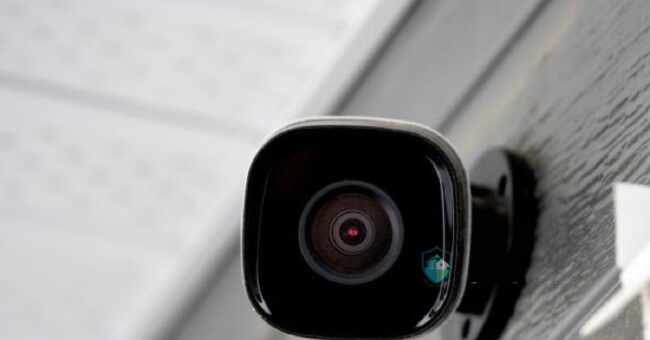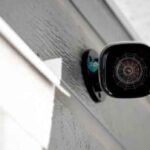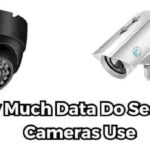Table of Contents
Have you ever wondered why do security cameras have bad quality? I know I have! Those grainy, blurry images simply don’t line up with our 4K HDR world where we can watch movies in crystal clear ultra high-definition.
It’s a frustrating issue I know all too well. Last year, grainy footage failed to identify the thief who broke into my home. I felt violated after the break-in.
Why had I bothered installing cameras that were useless when it really mattered? After dealing with poor video quality myself, I researched the root causes. I discovered many factors that degrade security camera footage, from outdated technology to real-world conditions.
So what gives when it comes to the video quality from security and surveillance camera systems? Why is CCTV footage still prone to issues like:
- Low resolution with pixelated images
- Lack of fine details and clarity
- Noise, distortion, and artifacts
- Poor performance in low light conditions
- Blurry motion and interlacing effects
In this post, we’ll dive into the various factors that contribute to subpar security camera video quality.
We’ll take a comprehensive look at the limitations of both analog and digital systems.
And we’ll discuss real-world installation and operation challenges that can degrade footage.
By the end, you’ll have a solid understanding of why many security cameras fail to provide the best possible video, as well as strategies to optimize for your needs and budget.
Let’s get started.
Analog Security Systems: Built on Outdated Technology
First, to understand why security camera quality is often lacking, we need to consider how the most common type of system works.
Analog CCTV technology has been around for decades and is still prevalent today.
Low Resolutions and Interlacing in Analog Cameras
Analog security cameras use older CCD sensors with interlaced video output. This means:
- Instead of recording entire frames at once, they break each frame into alternating sets of odd and even lines.
- They capture video with resolutions of 720×480 or lower.
- The interlacing causes jagged edges and motion artifacts.
Professional HD analog cameras max out at 1080i resolution with interlaced fields. Consumer webcams these days have higher quality!
Lack of Detail and Noise in Low Light
In addition, analog cameras struggle in low light conditions. Their sensors aren’t very sensitive, so they produce grainy and noisy images without adequate illumination.
Most have fixed aperture lenses without advanced noise reduction. So night and indoor footage becomes a dark, blurry mess.
The Compromises of Digital IP Camera Systems
IP network cameras seem like the obvious solution. Digital systems convert images to digital video for transmission and storage.
This enables features like:
- Higher resolutions up to 4K
- Larger image sensors and better low light performance
- Remotely accessible footage over computer networks
However, most IP cameras still make compromises on video quality:
Video Compression Reduces Quality
To save bandwidth and storage space, IP camera footage is highly compressed using codecs like H.264 and H.265.
- Higher compression means lower video quality, even at HD resolutions.
- Footage artifacts like pixelation and color banding occur.
Bandwidth Limitations for High Resolution Video
Speaking of bandwidth, transmitting uncompressed HD and 4K IP camera footage requires significant network capacity. Most networks can’t handle more than a few full resolution feeds.
To avoid maxing out bandwidth, resolution and framerate are lowered. This reduces video quality.
Cost Constraints for Advanced Camera Hardware
Finally, megapixel image sensors, quality lenses, and robust image processors don’t come cheap!
Most IP cameras use cheaper hardware to keep costs down. But this also results in some compromises on video quality.
Real-World Installation and Operation Challenges
Even if you invest in a high-end security camera system, you can still encounter video quality issues in the real world.
Problems like:
Poor lighting conditions – Too much light can blow out images. Too little light obscures footage.
Suboptimal camera placement – Obstructed views, incorrect mounting, improper angles.
Environmental factors – Weather, humidity, temperature extremes.
Inadequate wiring – Low quality or incorrectly installed cabling degrades video transmission.
Lack of maintenance – Dust, debris, spiderwebs. No camera lens cleaning or adjustments over time.
No optimization – Settings like brightness, contrast, saturation often need tweaking after install for ideal quality.
Proper installation combined with periodic checks and maintenance is essential!
Strategies for Enhancing Security Camera Quality
Now that we understand the key factors that degrade video quality, let’s discuss techniques to maximize quality:
Choose the Right Camera Resolution and Features
- For detailed identification, opt for at least 1080p HD resolution. Go higher if your network and storage can support it.
- Select cameras with larger, newer CMOS sensors for best image quality. As well as IR night vision capability.
- Seek out advanced image processing features like wide dynamic range (WDR), low light noise reduction, and intelligent video analytics.
Use Video Compression Wisely
- H.264 and H.265 are efficient compression formats – just don’t crank the quality reduction too high!
- For high traffic areas, prioritize framerate and image quality over resolution.
- Use motion activated recording and video analytics like motion search to minimize less relevant footage.
Enhance Low Light Visibility
- Add supplemental IR illumination to improve night vision quality.
- Choose cameras with Starlight or low light optimization.
- Enable WDR mode to balance bright and dark areas.
Invest in Lenses, Sensors, and Cabling
- Spend more on lens quality – varifocal lenses allow adjustment of focal length and focus.
- Newer backside illuminated CMOS sensors offer better low light sensitivity.
- Use shielded Cat6 Ethernet cables or fiber optics for signal integrity.
Focus on Coverage vs Quality
- For wide area surveillance, opt for more lower resolution cameras vs fewer hi-res ones.
- Prioritize real-time monitoring quality over recorded video quality.
- Store short high quality clips, not continuous streams if storage is limited.
The Future of Security Camera Video Quality
While current systems have limitations, new technologies on the horizon will continue improving CCTV and surveillance video:
- 4K and higher resolution – More megapixels provide finer details and digital zoom.
- H.265 video codec – Offers double the compression efficiency over H.264.
- AI and edge computing – On-camera analytics will enhance efficiency and quality.
- PoE and wireless systems – Make installing and powering cameras easier.
- Varifocal and PTZ – Enable remote lens adjustment and direction control.
Why Do Security Cameras Have Bad Quality
To quickly recap, the main factors that contribute to low quality security camera footage include:
- Analog systems with interlaced CCD sensors
- Highly compressed digital video
- Inadequate lighting, camera placement, and installation
- Network bandwidth constraints
- Budget limitations on camera hardware
Focusing on Priorities
It’s important to focus on your primary video needs:
- Live monitoring vs recorded video
- Coverage area vs high detail identification
- Real-time viewing vs high resolution storage
And balance video quality with available storage capacity and retention duration.
Optimizing camera settings and features for what matters most will provide the best results.
Comparison of Camera Technologies
| Camera Type | Video Quality | Installation Difficulty |
|---|---|---|
| Analog | Low | Easy |
| Digital IP | Medium | Moderate |
| 4K IP | High | Complex |
Actionable Ways to Improve Video Quality
Here are some actionable tips to start improving your CCTV footage:
- Clean camera lenses and enclosures regularly
- Adjust iris, shutter speed, and light levels
- Enable WDR and low light image enhancement features
- Use supplemental lighting like IR illuminators
- Upgrade to higher resolution sensors and lenses
- Optimize video encoding settings
- Use H.265 over H.264 for better compression
- Employ intelligent motion detection and activation
- Schedule periodic maintenance checks
Following even a few of these best practices can go a long way!
Frequently Asked Questions
Still have questions about security camera video quality? Below I’ve addressed some of the most common FAQs.
Why Aren’t Security Cameras Hd?
Many security cameras, especially older analog CCTV models, max out at standard definition resolutions like 720×480. HD resolutions require digital IP camera systems.
While HD is now common, full HD 1080p and 4K resolutions remain expensive and require ample network bandwidth and storage capacity.
For large surveillance systems, the cost may not justify the benefit of higher resolutions. But for covering critical areas, HD and 4K cameras are worth considering.
Why Are Security Cameras Blurry?
Blurry security camera footage usually comes down to one of these factors:
- Low light conditions causing noise and graininess, especially with analog cameras
- Strong video compression sacrificing clarity to save bandwidth
- Low quality, damaged, or dirty camera lenses
- Improper focus or framing of the cameras
- Inadequate network bandwidth causing reduced resolutions
Following the tips mentioned earlier around lighting, camera placement, lenses and compression can help maximize clarity.
What Are The Bad Things About Security Cameras?
Some potential downsides of security cameras include:
- Video quality issues as discussed above
- Blind spots or gaps in coverage if placement isn’t optimized
- Cybersecurity risks if the camera network isn’t properly secured
- Privacy concerns and legal compliance requirements
- Significant costs for purchase, installation, storage and maintenance
Proper planning, setup and operation can help minimize these downsides.
Why Do Security Cameras Go Bad?
Like any technology, security cameras can malfunction or degrade in performance over time.
Common causes include:
- Accumulated dust, dirt and grime blocking the lens or sensor
- Age-related wear on components like sensors and processors
- Moisture, extreme temperatures or other environmental factors
- Power surges frying circuits
- Buggy firmware needing an update
- General mechanical failure of moving parts like PTZ mounts
Regular inspection, cleaning and maintenance helps avoid issues.
What Security Cameras Have The Best Resolution?
Currently, 5MP and 8MP 4K ultra HD security cameras offer the highest resolutions. Options include:
- Hikvision 5MP Super Series
- Dahua 8MP Varifocal Bullet Camera
- Amcrest UltraHD 5MP ProHD
- Honeywell Performance Series 4K IP Cameras
- Axis Communications Q3515-PLVE 5MP Camera
These provide extremely sharp, highly detailed video. But also require substantial network and storage capacity.
Is 720p Better Than 1080p For Security Cameras?
720p resolution is sufficient for many surveillance applications. 1080p offers more detailed video for identifying people or objects.
However, if bandwidth or storage is limited, a properly set up 720p system may provide better quality than a starved 1080p system throttling resolution.
Lighting, lenses and encoder settings ultimately impact clarity more than resolution alone.
Do Burglars Avoid Security Cameras?
Studies show most burglars actively case targets in advance, and the presence of visible security cameras does deter break-ins.
However, cameras focused solely on entries may miss Blindspots like side or backyards.
Integrating dummy cameras along with real ones can make coverage appear more expansive.
Monitoring and prompt reporting also increases the chance thieves get caught, further deterring crimes.
What Is The Failure Rate Of Security Cameras?
It varies by environment and model, but industry estimates suggest around a 3-5% annual failure rate for security cameras.
Higher traffic public areas and outdoor installations in extreme climates have higher failure rates.
Regular maintenance and testing redundancy in mission critical surveillance areas is advised.
Do Burglars Care About Cameras?
Yes, security cameras can be an effective burglary deterrent, especially when combined with alarm systems and prominent warning signs.
While cameras may not stop determined thieves, studies show they give pause to opportunistic criminals seeking easy targets. Real-time monitoring and fast police notification increases deterrence.
Conclusion
Now you know the main reasons security camera footage often leaves much to be desired:
- Analog systems use dated low resolution interlaced video.
- IP cameras compress video leading to artifacts and noise.
- Real-world conditions introduce lighting, installation, and maintenance challenges.
- Cost constraints limit camera hardware capabilities.
But being aware of these limitations is half the battle. Focus on the fundamentals like proper placement, lighting, and cabling.
Choose the right camera technologies for your specific needs and budget. And optimize your system’s software settings and storage.
By taking a comprehensive approach, you can certainly improve your CCTV video quality, even with today’s imperfect equipment.
Just set clear priorities and expectations, and continue enhancing your system over time.
What has your experience been with security camera video quality? Let me know in the comments below!
What questions do you still have? What topics would you like to see explored further? Let me know in the comments!




